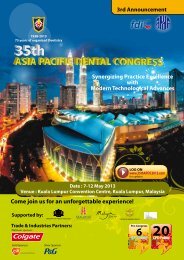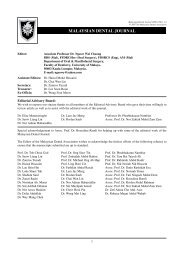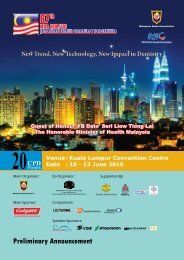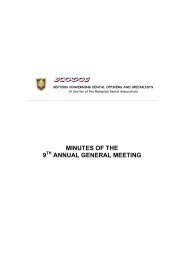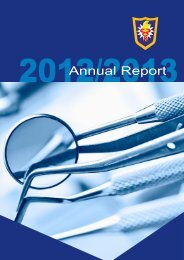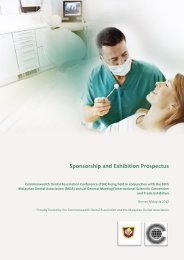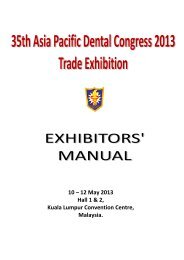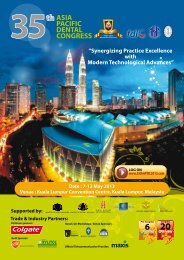PDF( 8mb) - Malaysian Dental Association
PDF( 8mb) - Malaysian Dental Association
PDF( 8mb) - Malaysian Dental Association
You also want an ePaper? Increase the reach of your titles
YUMPU automatically turns print PDFs into web optimized ePapers that Google loves.
Shamsher / PhrabhakaranFigure 8: Photographs showing the severity of eachlevel of bitemark. © Dr. Iain Pretty, http://www.forensicdentistryonline.org/bitemark_index.pdf. (Usedby permission)Another reason the police should cause bitemarksto be so examined, regardless of the availability of otherevidence, is that such examination will promote thedevelopment of bitemark cases in Malaysia. Hitherto,there is no <strong>Malaysian</strong> case-law which reports that bitemarkevidence was presented in court, let alone it was relied onas a basis of the finding of guilt or acquittal. The morebitemarks are examined, the more will be known abouttheir reliability in proving the identity of a biter.This is important so that in cases where only abitemark is available, then the police, the prosecution, thedefence counsels, the trial judge and even the public willbe able to appreciate its evidential value. Interestingly,DNA analysis was practically unheard some 20 years agobut, because of the determination shown by the police andthe forensic scientists in finding new ways to fight crimesand criminals, today it is an established investigativetool. 48Secondly, the forensic odontologists must becareful when making any decision since once they writesomething in a report or say something under oath, theyown that forever; good, bad or indifferent. 49 For thatreason, in Malaysia, the methodology employed in abitemark examination and the terminology used in thereporting of bitemark evidence should be standardizedso that no matter where the bitemark is examined andby whom, the conclusion will be the same and the wordscontained therein will carry the same meaning. In US, theduty to ensure such uniformity is carried out by the ABFO,which regularly conducts workshops and issues guidelinesand standards pertaining to the general practice of forensicodontology to ensure that one member’s opinion is as goodas the opinion of any other member.1However, given the fact that there are only ahandful of forensic odontologists in Malaysia, the prospectfor the establishment of the <strong>Malaysian</strong> Board of ForensicOdontology may not be feasible, even in the near future.The duty to ensure such professional uniformityshould instead be placed on the shoulder of <strong>Malaysian</strong><strong>Dental</strong> <strong>Association</strong>, <strong>Malaysian</strong> <strong>Dental</strong> Council, Ministry ofHealth or other relevant authorities regulating the practiceof dentistry in Malaysia, in collaboration with the criminaljustice agencies like the Royal Malaysia Police, AttorneyGeneral’s Chamber, <strong>Malaysian</strong> Bar Council and ChemistryDepartment.Thirdly, selected dental officers at the governmentalhospitals in Malaysia should be given a formal training inthe field of forensic odontology so that they are familiar withthe roles and responsibilities of a forensic odontologist. Aforensic odontologist is required, inter alia, to apply dentalknowledge in identifying, weighing, collecting, preserving,examining, interpreting and reporting bitemark evidence.More importantly (and without derogating from thegenerality of the aforegoing), forensic odontologists mustbe trained to reach their conclusions independent of anyother evidence. In short, they should not tailor-make theirfindings to corroborate other evidence or to support oroppose the police’s case against a particular individual. 17Bang advised that forensic odontologists should start allinvestigations with an open mind and when they findevidence in disfavour of one person, they should not runaway from the responsibility but express exactly theiropinion. 17 Similarly, Bowers contended that knowing asuspect was caught crawling through the window doesnot add any weight to otherwise non-probative bitemarkevidence. 50 Put it eloquently, forensic scientists shouldnot navigate scientific waters with an eye fixed solely onconclusions but must navigate with a critical eye focusedfirmly on the methods dictated by logic. 49Furthermore, forensic odontologists must also betrained to give only scientific reasons to support theirconclusions. Nordby explained that reasoned opinionsdeveloped from scientifically acceptable methods willavoid subjective, unsupported and untested hunchesand guesses. 49 Likewise, Bowers contended that suchopinions will boost the reliability of bitemark evidence andcommented further as follows:The interpretation of a bitemark case must be determinedby methods that are reproducible and obvious. The “Ican see it, you can’t?” school of expertise will not leadus into the 21st century. Instead, it will spell the doom ofthis particular aspect of crime investigation. An opinionis worth nothing unless the supportive data is clearlydescribable and can be demonstrated in court. 50For that reason, the law provides that where theopinion of an expert witness is relevant in a courtproceeding, the grounds on which his opinion is basedare equally relevant in that proceeding. 51 The purpose isto give an opportunity to such witness to justify his or heropinion and in the event no such justification is given, thatopinion shall be rejected by the court. In the case of SimAh Song v Rex (the facts of this case are irrelevant), ChiefJustice Brown held as follows:125



